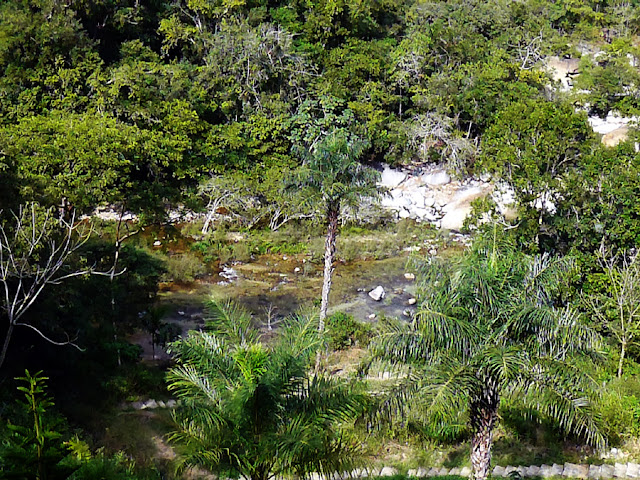Puerto Vallarta
Our Xmas present this year was to visit with our dear, dear friends from Los Angeles, CA....Nichole and Thiago. As fate would have it, Thiago y Nichole were visiting Puerto Vallarta for a destination wedding, and we being a short van drive away jumped at the opportunity.
Although we were housed across town from each other (Thiago y Nichole in Nuevo Vallarta & Brad and I in Viejo Vallarta) we were able to see and visit as often as our time allowed. Our initial visit brought gifts galore! And so after a sumptous breakfast we were off to explore Viejo Vallarta.
Brad y Nichole at Blue Shrimp Restaurant
At the same time modern Vallarta seeps through...as seen by this sculptural structure. To this day I still don't know what its purpose is...but it loomed large on the Malecon.
Brad y Nichole Shopping
Brad had noted a Tianguis, or makeshift market on the way into town, so we headed towards the artesania center of town. A wide array of folkart was shown and available for our pleasure...and of course, we needed to appreciate the work and find some lovely souvenirs for our collections.
Huichol Artesanias
Strollin'
We spent quite a bit of time at the Tianguis...and then realized we were hungry...again! So off toward the Malecon we headed to stroll, engulfed by ocean winds, sparkling sunshine and surrounded by amazing public art.
"Sutil Comepiedras"
“The Millenium”
At Gran Velas in Nuevo Vallarta
We actually did contemplate a siesta, but just for a moment. We realized there was much to do and see and so little time. Before we knew it we were in "post siesta" mode, headed to Nichole's and Thiago's crib for a spot of dinner. We dined in grand style and took in our beautiful surroundings.
Nichole on Alejandro Colunga's bronze sculptural chair
The moon was almost full and illuminated the grounds and ocean perfectly. We headed for the ocean adjacent/pool cabanas, guitar in hand. A lovely staff member brought us sheet sized towels, water and juice boxes for our concert, then discreetly disappeared.
Cabana Singing
Could life get any better than this?
What A Little Moonlight Can Do...
We broke out the "Rise Up Singing" books and got to it. We channeled our Music Group a bit, altered from our regular song path and tried a few new tunes...always returning to our heartfelt standards.
As the ground and pool lights were being turned off, we decided to call it a night and bid our lovely friends a pleasant slumber.
PUERTO VALLARTA BOTANICAL GARDENS
Our next day brought us a lag in our touring schedule. We were all recuperating from the annual cold to some extent, and Nichole and Thiago decided to stay in to rest. Brad and I had read about the P.V. Botanical Gardens and decide to make the trek. We were both very glad we did.
The creation of Vallarta Botanical Gardens has provided an unprecedented opportunity for our community to share the wonder of the vast diversity of Mexico’s plant species with the world. We have assembled botanical collections in a safe environment with viewing trails and have already built the most-visited public collection of orchids in the country of Mexico.
And the trails were stunning. We started off by heading down to the rio, which ran at the base of the mountain upon which the Botanical Gardens' Hacienda de Oro building was perched. The trails have been lovingly maintained, yet left somewhat raw, enough to allow them to embrace their beautiful natural surroundings.
Fco. Coolin' The Ole' Tootsies
Local Aves
River Brad
Beauty
Our trek back out of the jungle, emerging from the rio was nothing less than Indiana Jones-ish. Now we were ready for some lunch and the Hacienda de Oro promised local, delicious fare. Set on a mountaintop, surrounded by lush jungle, our table and view were breathtaking.
Botanical Garden Entrance
Jungle View
We dined on Seafood Stuffed Avocados and Blue Corn Fish Tacos. All the food was fresh and tasty. We couldn't imagine what efforts it took to cart the staff and numerous items to this jungle top Xanadu to create such a delicious experience.
One of the culinary quirks we experienced was the ceramic, hand crafted taco warmer presented to us for our lunch. The jungle has a tendency toward cooling winds and the restaurant has fashioned these taco cozies to keep the food warm...ingenious and beautiful.
Blue Corn Fish Tacos
Mary y Rodney Commemorative Plaques
The Puerto Vallarta Botanical Gardens are a (501) c3 organization, reliant on donations. They have a main staircase covered in commemorative tiles, honoring the donors. Mary and Rodney apparently supported the gardens, and their Dos Amigos Side By Side plaques caught my heart and eye.
For One Minute
So did this One Minute graffitti on one of the side streets of Puerto Vallarta.
Para sailing Spidey
And this para sailing Spidey seemed to echo childhood laughter, still resonating in my soul.
Los Amigos
So from our home to yours we wish you the happiest of seasons and new year.
































































